
Clicking on Map will bring up larger (1 Meg) image
The Exalted Dawning
A fantasy RPG campaign crossbreeding Earthdawn and Exalted in a
non-published world-setting.
This page takes a bit to load, a lot of pictures are in
here...
THE REALM OF ATHOR

Clicking on Map will bring up larger (1 Meg) image
INDEX
History
Major Features of the Realm
The City Kingdoms of the Empire and beyond
The Game Session Log - coming soon...
HISTORY
Upon this world there lived two races, Man and Orrak. The Orrak ran free in the hardy
wilds and Man lived in the lush and fertile lands where he built his cities. Though wars
did sometimes rage between the races, even amongst themselves, the world was at peace.
Then there was the coming of the Infernum, ending the Fifth Age.
Bitter creatures from beyond all that man has known, they traveled to this world and
devastated it. Even the mighty dragons were unable to stop them. Slowly the last of the
people of this world gathered in Athor, the remaining safe realm. It served as the final
bastion against the dark forces that twisted the surrounding realms. Here the people cried
out to the ancient gods for saviors, and the ancient gods cried out to the Mother, the
living essence of this world, a Celestial. But the Infernum and their hunger to devour had
weakened her, so she called to the other Celestials.
A pact was born as the ancient gods were willingly slain by the Celestials and their power
tied to the heavenly beings. Even the Mother did take the power of her own children, the
dragons. And thus the power was given to the people. The Mother gave the dragons’
power to some of Man and they became the Sylvan (sill-vin), who would be forever marked by
the dragon-blood that empowered them. The Moon took the power of the goddess of the beasts
and gave it to the Orraks, making them the Skarans (scar-ans), who would find the power to
shape themselves into bestial forms. The Great Orbs of Light took the builder’s power
and gave their prophecy to those men who would be Duagirda (dwa-gird-ah). And finally the
Great Father Sun took the power of the strongest protector and created the Cederi
(si-dairy). These would form the army of the light, driving the darkness back from Athor.
But the rest of the world was lost as the Mother Celestial died, leaving Athor all that
would be livable.
The Cederi ruled the people wisely and kindly for untold ages. But eventually they fell to
the very corruption they sought to banish. The Sylvan rose up, for they were greatest in
number, and slew the darkened Cederi and all the others who were empowered by the
Celestial forces, the Skarans and the Duagirda. The Sylvan took up the reigns of power as
the Celestial allies were destroyed or banished from Athor for their dark deeds.
The Sylvan ruled well until the coming of the Malfaes. After the Great War the borders of
Athor had become unpassable. Mountains too high too climb in the West, frozen snowdrifts
to the North, a tempest in the sea to the East and a boiling cauldron in the sea to the
South. It was a shock to the people when the first of the Malfae came through these
borders and attempted their own invasion of Athor. The Sylvan brought their people to the
inland sea to the great island of Drakos. Here one Sylvan would rise above the others,
grasping the old artifacts of the Cederi and using them to stop the Malfae. She was
Aluaran, named after an ancient god from before the Great War. She would rise as Empress
to Athor and rule for hundreds of years.
Recently the Empress has vanished, though most are unaware of such. It is said she is on
sabbatical, meditating upon a new threat that has arisen, the Deathlords and their
servants the Lahrago. The Lahrago are very much like the Cederi, but their powers deal in
death and the spirit realms, places sane folk never touch upon.
In the wild lands, far from Drakos, the descendants of the few remaining Skaran live, the
Beast-Peoples, led by the greatest of their number, the Orks. In these wild lands many
Malfae still run free and mingle, and even rule, the common peoples so far from the seat
of the Athorian Empire. And still there are those races of Malfae that have come about
that live with mankind. And finally there are the Infernals, those touched upon by the
Infernum and given the same kind of power as the other Celestial touched once had.
Return of the Cederi
In recent years the Cederi have returned, their eternal spirits reborn into a new
generation of heroes. Unfortunately the old religions of the Realm have made it clear that
the Cederi were corrupted denizens who ruled through tyranny, the people of Athor. So
these new Cederi must hide their true power and form. Along the way they have discovered
that not all Duagirda and Skaran have died as well, and the Celestial powers slowly return
to this world as the powers of the Sylvan begin to inexplicably weaken bit by bit with
each generation.
You are a Cederi, your soul is older than most can count. You are empowered by the
Celestial Sun to do his bidding. When your kind was darkened, his back did turn to you,
but your penance is almost done and the time to bring light to the world is upon you
again. You can return to the hero you were, the Celestial Sun has graced you with his
light once more; will you rise to the challenge that your former self failed before? Can
you set right a world in chaos, surrounded by darkness?
You are Cederi
You will play the role of a Cederi reborn. Within you resides an ancient spirit, and the
Great Father Sun has sparked the power that lay dormant within it. You may have brief
visions of a past life, lived over a thousand years ago, long before your ancestors were
even born, you may even gain an ability or two that your spirit once possessed when it was
someone else, a powerful Cederi that ruled Athor long ago. But you are not that Cederi,
that hero fell from grace. The spirit that resides within you has been given a second
chance, with you. There are no voices that speak in your head, no advice from times past;
simply a power, a few memories, and knowing that the Great Father Sun has placed into you
the spirit of a hero so that you can do what they did not.
At some point, your character encountered something, had a revelation, etc. You suddenly
could do something, knew something, saw things, which you never could before, and you
could do so at magical levels. Thus you were given a vision from the Great Father Sun,
where you had a glimpse of who your spirit last inhabitated as a Cederi so long ago. Thus
you were given the intimate knowledge of what you must do.
FEATURES OF THE REALM
Athor is a land of conflict, contradiction and beautiful harmony, all at once; her borders
defined by both natural and mystical barriers and her people an elegant yet unrestrained
mix. Athor is roughly two months good riding from the base of the Koln Mountain Range to
the city of Coasthaven and about one and one-half months good ride from the delta of the
Serpent’s Run River to Hisilome. Her Western borders are consumed by an ever-rising
mountain range, the Koln, the Solace Forest of huge redwoods and sequoia trees, and the
Sea of Tears, formed by the eons of slight melting off of the Ice Fall glacier range which
occupies her northern border along with the coniferous Frostwood forest. Here the snowfall
occasionally comes down a half-week or so ride south of the Frostwood in winter. Her
eastern border leads to the Stormsea, and several days sailing to the east ends in certain
death at the hands of a sheer wall of violent tempests both on and under the water.
Traveling south from Athor, the waters of Firesea and sky begin to heat until finally they
boil and burn anything sailing on them or attempting to fly over them. Even the southeast
portion of Athor has become a somewhat inhospitable climate known as the Badlands, as
great winds sweep across the heated scrub-plains and deserts, with only pockets of fertile
land escaping the dry windy heat.
The major inland features of Athor are:
Solace Forest: This mighty forest of giant redwoods and sequoias reaches
up and around the eastern edge of the Sea of Tears. It is a thick canopy, sometimes half a
mile in height. Most airships barely can get over the treetops to sail to some of the
smaller ports within the wood. Many of the villages are built up into the trees as large
predators can sometimes roam the ground in some of the deeper areas close to the Koln
range. Here is the beginning of the Deepstone River, a huge waterfall cascading from miles
up the Koln range, making its way to the Firesea in the south. The southernmost reaches,
just outside the Empire’s direct control, house villages of Malfae; creatures that
somehow have survived crossing the great barriers that keep Athor safe from the Infernally
warped lands beyond and made the adaptation to this stable realm. The Empire maintains
moderate control here.
Sea of Tears: As the Ice Fall glacier slowly melts a never-ending supply
of water, the Sea of Tears stays cold; so cold that its Northern shoreline is a frozen
shelf of ice. A huge waterfall comes off the Koln here, bigger than the source of the
Deepstone. Huge species of aquatic creature that survived the Scourge live here. On the
large island of Drakos, the current center of the Realm, a nesting ground of drakes lives
in the cliff-faces that exist on the Southwest side of the island where the lands is
higher and drops into the sea. Networks of caves exist, burrowed into the side of the Koln
near its great waterfall. Pirates sometimes roost in these caves in summer. The Sea of
Tears breaks off into the Serpent’s Run River, which Deepstone eventually joins. This
river is a fast during spring and slow moving during the winter months. The heart of the
Empire.
Sucursal Mountain Range: The Sucursal separates the heat of the Firesea
from the cold of the Ice Fall. It is climbable, and some small villages exist along its
base as well as up in the mountain range itself. Here atop a huge blasted plateau, once
sat the seat of the realm, the mythical land of Alagar. Deep caves still contain ruins of
the once powerful kingdom, shattered statues to ancient gods and otherworldly powers
reside lost in the depths of this mountain range. The Empire has some control over the
western half of this range.
The Shroud: A huge oaken forest with a deep ground-layer that extends for
hundreds of miles. The shroud occupies the lowland area just north of the Sucursal and
even works its way up the mountain a bit. The forest is deep and foreboding and tales of
Skaran and Lahrago come from this place constantly. All sorts of tales of dark strange
ethereal creatures spring from this huge wood. The Empire almost seems to fear this place.
Falshar Mountains: A lush nearly tropical mountain landscape, heated and
humid from the waters of Firesea. It keeps the excess heat out of the valley just to the
north, but not the moisture. Much of the land around this mountain is swamp and warm bog.
Several races of the beast-people live here, descendants and followers of the Skaran Orcs.
The Empire has little control here.
Berkanium Mountains: A pristine range in the northern lands of Athor, the
Berkanium is the only known source of precious metals not under the control of the dwarves
of the Koln range. It has a standard level of vegetation and temperature extremes and is
one of the most stable areas in the realm. The Iceshard river begins in this area, several
smaller rivers carrying bits of ice and snow from the Ice Fall, converging. This river
goes on to join the Ash river heading east. The Empire has moderate control West of here.
Note: This is the one known Celestial Nexus you are aware of, on the
eastern side of the mountain.
Frostwood: Here the coniferous forest full of frosty mist stretches
across the northernmost boundaries, separating the lands from Ice Fall, and some say
stopping the glacier from encroaching further south. The frostwood is home to at least one
city controlled directly by the Lahrago. The mist has a slight unsettling quality on those
not used to it. Travel at night in the wood is only for the truly brave, or the truly
insane. A number of Malfae savages rule parts of the wood in the dark of night, barbarians
who war with the few Skaran clans that also live in these icy woods. The Empire has no
hold here.
Vulcun Mountains: Black rocky terrain, little vegetation, and the
surrounding land dark grayish clay. This is a good description of much of the land
directly around the Vulcun. The Ash River goes along a stark gray sandy plain here, unlike
the fertile lands to the west of the Berkanium. The gray silt drifts into the river
constantly, joining the Iceshard to dump into the Gulf of Stars. The Gulf so named for the
silt that has settled within it gives it a polished appearance on many nights reflecting
the night-sky above. The Vulcun is home to a number of Infernal creatures and their
servitors. The Empire has no hold here.
Badlands: For as long as the people can remember the scrubby dusty plains
and deserts of the Badlands have existed. Now this outback region serves as the home to
most of the Orc peoples and their Skaran patrons. Skullpass Mountains also sit here, a
dusty pass between this and the Sucursal, where many of the wild ones live. A great number
of Malfae live in this area of the pass, warring with the Orcs who inhabit much of the
Badlands out to the shores. The shoreline here is a constant state of dunes and small dry
weeds, buffeted by Stormsea and heated by Firesea. The Empire has no hold here.
Banyan Archipelago: The warm currents here give rise to this set of lush
tropical islands. Exotic creatures and people inhabit these, getting along fairly well
with the Malfae, Skaran, beastpeople and other inhabitants. Here the jungle and its power
is far greater than the Falshar range and the Empire has no hold here.
THE GREAT CITIES
These are the great cities, they hold the most population in the known world of Athor. The
cities serve as the centers of most areas, with anywhere from zero to twelve surrounding
farming communities and one or two large towns on the outskirts away from those farming
communities. In those cities where the Empire holds sway, a branch of the royal family
will sit, their leader sitting as the city’s governer and the rest of the family
administering the surrounding province’s towns and villages. Most of the
population is centered around these areas, even those not belonging to the Empire.
Those with suitable farming areas usually have several outlying farms ringing the city,
with those farms along the roadside serving as bed and breakfast inns. This usually
serves for travel about two days out from the city. Then another two day past those
farms along the roads (4 - 5 days total from the city) sit the one or two large towns and
small villages.
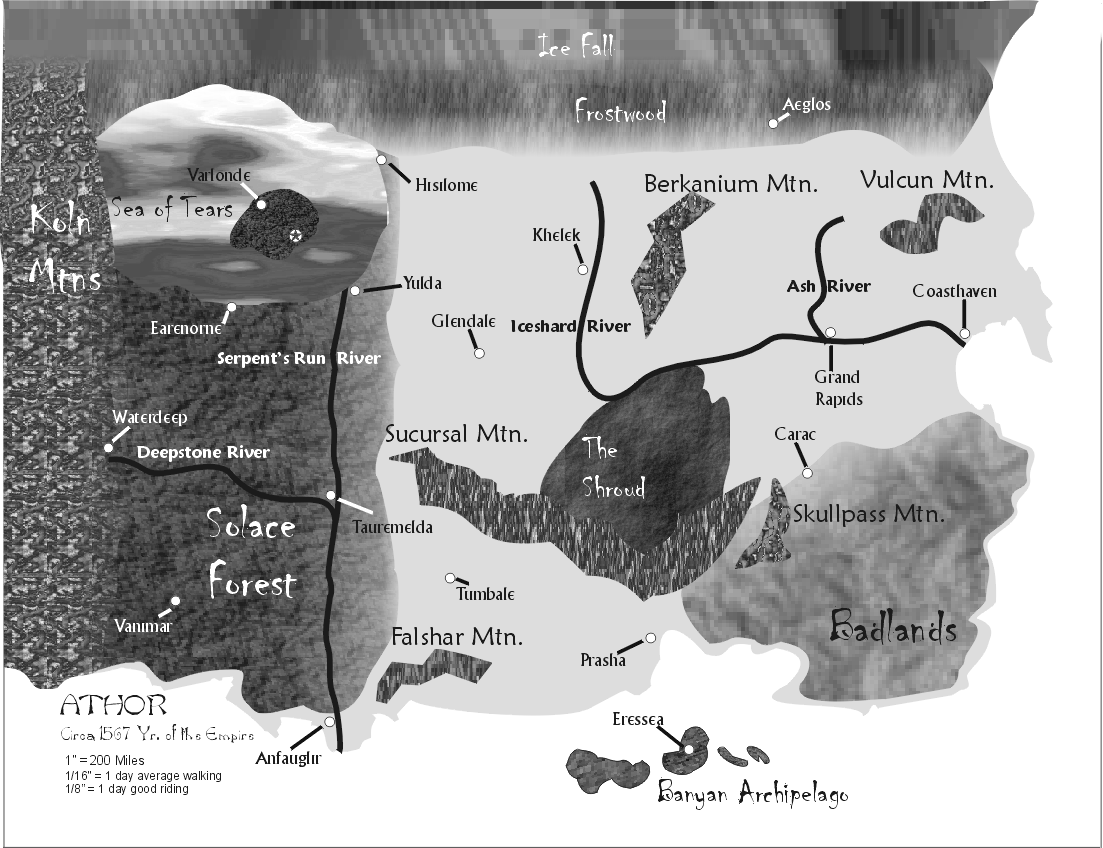
GREAT CITY MAP
Clicking on the map will bring up a larger (1 Meg) image
AROUND THE SEA OF TEARS
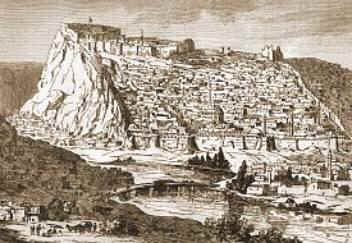
Varlonde: Built up along the side of a rocky hill topped by the palace of
House Peleps (water-bloods). Varlonde serves
as the headquarters for the Imperial Navy, patrolling the Sea of Tears for the pirate
guilds. The military presence here makes up
most of the need for workforce, followed by trading with the hunters of the Frostwood,
northwest of the Sea of Tears. House Peleps controls the navy getting most of their
ship materials from Hisilome to the north. House Peleps also has the advantage that
most of the judges in the Imperial Courts are from their family line.
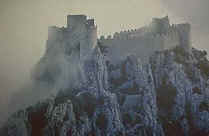
Hisilome: A rugged outpost city held over from the last age, it was
resettled only in the last few centuries. It has grown a bit more prosperous and
left its stone and log buildings behind for a more civilized look. A small wall
surrounds the town, made of ironwood, a short straight-trunked tree that grows in the
region where the Solace and Frostwood forests meet. Sitting up high above the Sea of
Tears at the western edge of the city is the castle of House Ledaal (air-bloods).
Logging of the ironwood is the primary industry here as the better air and water ships are
made of it, but an old spirit named Elder Oak maintains a vigil over the forest and those
who rape or pillage the wooded resource are soon found dead at the city gates.
Loggers are careful to replant that which they take. A group of tribal barbarians
who worship Elder Oak feel bereft of their spirit and therefore cause a great many costs
on their attacks against the loggers and their encampments. Added to this is the
fact that the city itself is constantly shrouded in mist, especially the castle
itself. The air is almost always rather quiet and to those not used to the dulling
of sound the mist makes, it can be quiet disconcerting. The ruling house regularly
hires mercenaries to do exploration runs along the northern areas of Athor, and seem to
take the most note of the activities of the Lehrago.
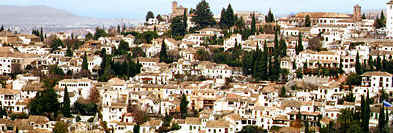

DEEP IN THE SOLACE
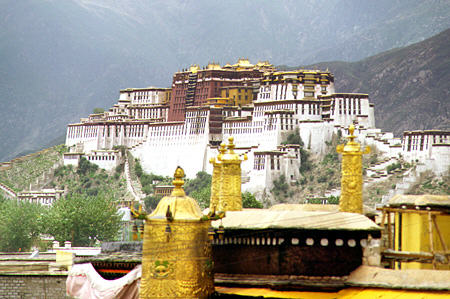
Waterdeep: Waterdeep is the city that sits outside the stronghold of the
Mountain Folk. A great waterfall cascades down the Koln alongside this entrance,
forming the Deepstone River. Here within the mountain, the dwarves mine precious
ores and metals that find their way out across all of Athor. From the central palace
(picture on right), House Nellens (no particular affinity) rules. They are a fallen
house, the result of a dalliance by the Empress some time ago. They maintain their
status by their business acumen and their ability to work well with the Mountain Folk.


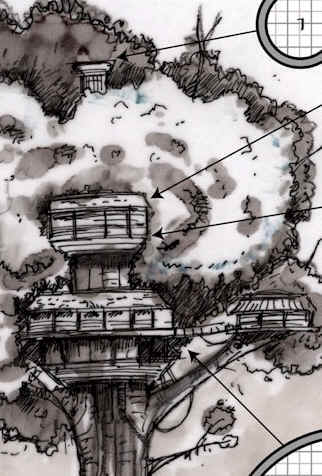
Vanimar: The tree-top folk of Vanimar have a refined and complex
society, marked by metalwork, large libraries, exquisite architecture and a unified
government. It's just all up in the treetops. A great deal of large creatures
and Malfae roam the forest floor, especially at night, in these parts, but do not bother
the Vanimarian people up in the treetops. A network of aerial bridges large enough
to hold most wagons exists to transport people around this forest-city. The people
here revere the trees as gods and treat them with love and respect. They also have
an affinity for the wild creatures and in some remote places outside the city, there are
animals that can literally speak and think as humans. Trade is not the easiest and
usually requires an escort or guide of some kind if the trader has not had numerous
experiences with navigating the Vanimarian area of the forest.


NORTHERN PLAINS

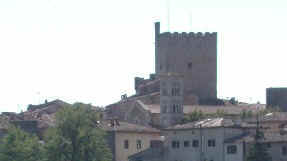

Khelek: A wide band of meadow stretches not far from the Iceshard River.
Here the various towns and villages connected to Khelek deal in great trade and
hunting of wild grazing animals that make use of the meadows. Trees and bushes here
overflow with edible acorns, berries and nuts; the plants pulling from the incredibly pure
waters of the Iceshard. The Khelek are known as warriors and form a barrier against
the remainder of the eastern lands. House Cathak (fire-blooded) run the city fairly,
and keep several Imperial Legions garrisoned in Khelek. Most visitors will find fair
and respectful treatment, but one slip and a nasty fate can await them.
THE GREAT EAST
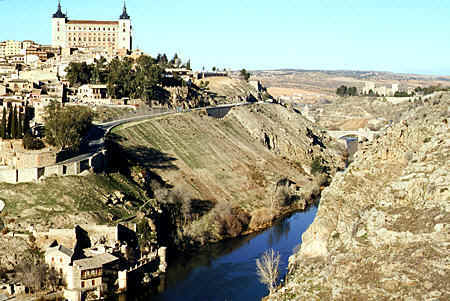


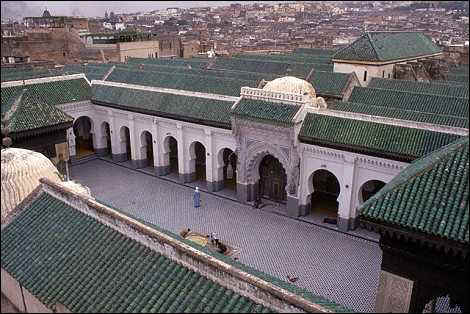

Carac: This city sits at the edge of the badlands, with its
red-clay built adobe and mosque-like buildings. The dry sand blows a fine silt
through much of the city, creating a light haze that is very visible in the early morning
and late afternoon. The vast majority of the population here are Orcs, banded
together from the various tribes. Skarans assist the orcs in ruling from the
background and this is one of the few places in Athor where one might find a
"civilized" Skaran. Carac is the gateway to the badlands, the last
civilized stop before going into that arid region. A council rules the city under a
chieftain. A smattering of humans also live here, and though a few of the Sylvan
call this place home, the dragon-blooded are not welcome overall and have no power here.
Houses here are sometimes built into the side of the rocky spires that jut out of
the ground.
FAR SOUTH



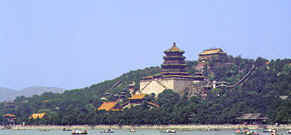
OF THOSE NOT MENTIONED
Details will be forthcoming on Aeglos and Drakos itself....